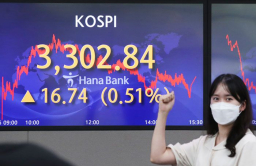-
KOSPI 2812.05 +41.21 +1.49%
-
KOSDAQ 756.23 +6.02 +0.80%
-
KOSPI200 376.54 +6.64 +1.80%
-
USD/KRW 1373 3.00 -0.22%
Seoul may curb margin loans to rein in household debt
Financial watchdog considers including margin loans in the calculation of personal debt service ratio
By
Sep 23, 2021 (Gmt+09:00)

South Korea is considering curbing margin loans offered by brokerage companies to stock investors, as part of the government efforts to rein in soaring household debt, which is estimated to have reached a record high of $1.5 trillion.
Margin loans, backed by securities held by the borrower, have remained in the regulatory blind spot areas because a raft of government measures introduced against household debt were mainly aimed at cooling the overheated housing market.
But with the balance of margin loans rising 33% so far this year, both the regulatory Financial Servies Commission (FSC) and the Financial Supervisory Service (FSS) under its supervision have begun discussions about possible measures to decelerate the margin loan growth, according to financial industry sources on Wednesday.
A measure under consideration is including margin loans into the calculation of the debt service ratio (DSR), or the debt principal against the borrower's annual income. Currently, the DSR is based mainly on mortgage and credit loans.
"We are keeping our eyes on the sharp increase in margin trading, which had been in the modest growth trend over the past 10 years," a financial regulatory official told The Korea Economic Daily.
"We are examining a broad range of measures, including taking into account margin loans for the DSR calculation."
The FSC plans to unveil a new set of measures next month, aimed at curbing household debt growth.
A margin loan refers to lending by brokerage firms against the value of the securities held by the borrower for stock purchases, at an annual interest rate of 5-7%. If the price of shares used as collateral falls below a certain level, the brokerage house is allowed to sell them.
LACK OF REGULATIONS
In contrast to tightened bank loans, the lack of regulatory curbs on margin loans was blamed for a surge in speculative stock investments, in particular, led by those in their 20s and 30s. The number of margin traders in their 20s has trebled to 13,893 as of end-June, versus 4,791 in December 2019.
Margin balances came to 2.9 trillion won for thirtysomethings and 532.4 billion won for twentysomethings as of end-June, rising 2.7-4.3 times compared with the end of 2019.
Currently, the DSR applies to borrowers of a loan against a home worth more than 600 million won in the regulated area, or a credit loan of more than 100 million won, starting from July of this year.
From July of next year, credit card loans will be included in the DSR calculation, meaning a further tightening on individual loans.
But regulators are concerned about a possible backlash against toughening margin lending rules from the young generation, who have been flocking to stock markets away from the unaffordable housing market. Further, they may switch to unregulated smaller-size financial services firms to take out loans, which charge far higher interest rates of around 10% per year than banks and brokerage firms.
| Soaring loans on margin accounts | |
| Dec. 30, 2020 | 19.23 trillion won |
| Apr. 30, 2021 | 23.55 trillion won |
| Sept. 18, 2021 | 25.46 trillion won |
| Source: Korea Financial Investment Association | |
The regulatory move against margin trading follows a series of warnings by top regulators and the Bank of Korea that South Korea’s asset market showed signs of overheating, driven by a record pace of household loan growth. The country’s outstanding household debt was estimated to have exceeded $1.5 trillion to reach a record high in July of this year.
FSC Chairman Koh Seung-beom said last month that his policy priority was on limiting economic and financial risks stemming from higher household debt and asset price fluctuations. He took office as the country's top financial regulator late last month.
Last month, the Bank of Korea ended its ultra-easy monetary stance by bumping up the base interest rate by 25 basis points from a record-low 0.5%.
Write to So-ram Jung at ram@hankyung.com
Yeonhee Kim edited this article.
-
Aug 22, 2021 (Gmt+09:00)
-
Aug 06, 2021 (Gmt+09:00)
-
Jul 08, 2021 (Gmt+09:00)





